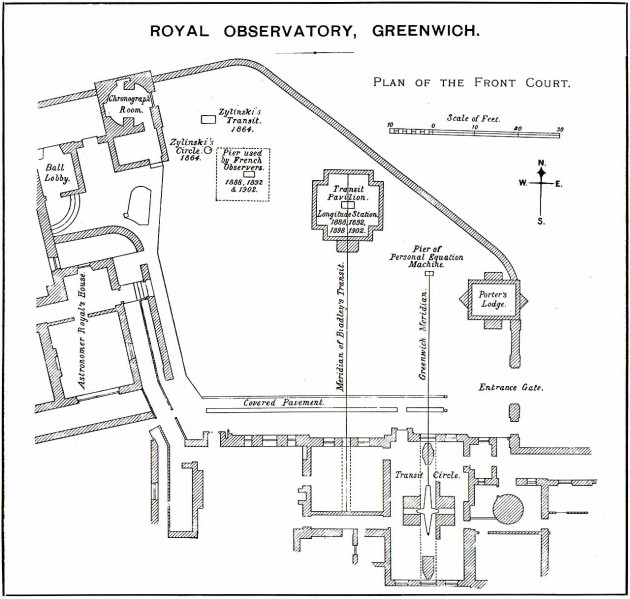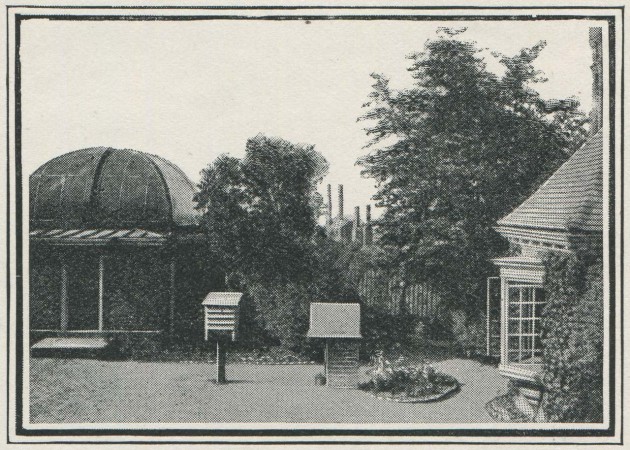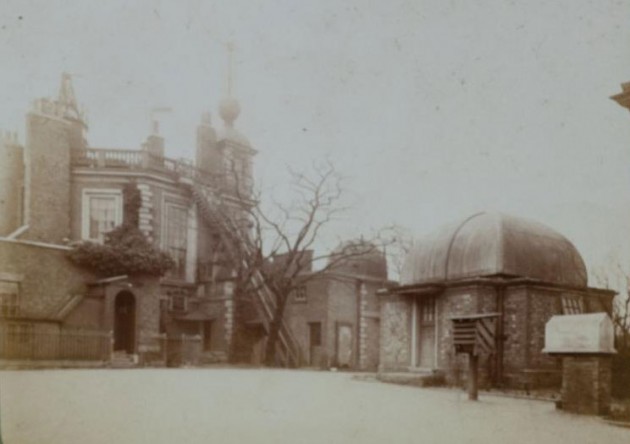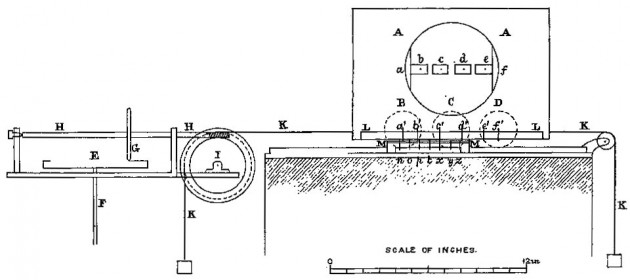…where east meets west
- Home
- Brief History
- The Greenwich Meridian
- Greenwich
(1675–1958) - Herstmonceux
(1948–1990) - Cambridge
(1990–1998) - Outstations (1822–1971)…
- – Chingford (1822–1924)
- – Deal
(1864–1927) - – Abinger
(1923–1957) - – Bristol & Bradford on Avon
(1939–1948) - – Bath
(1939–1949) - – Hartland
(1955–1967) - – Cape of Good Hope
(1959–1971)
- Administration…
- – Funding
- – Governance
- – Inventories
- – Pay
- – Regulations
- – Royal Warrants
- Contemporary Accounts
- People
- Publications
- Science
- Technology
- Telescopes
- Chronometers
- Clocks & Time
- Board of Longitude
- Libraries & Archives
- Visit
- Search
The Personal Equation Machine (used with the Airy Transit Circle)
The Personal Equation Machine for use with the Airy Transit Circle was erected in 1885 on a specially built pier in the courtyard, directly on the line of its meridian. Its position is marked on the plan below. A description of the instrument was published by Christie in both the 1885 Report to the Board of Visitors and in the introductions to the 1885–99 volumes of Greenwich Observations. A transcript of the 1899 version is given below, as is the more comprehensive description, (with one technical diagram), that was published in Monthly Notices of the Royal Astronomical Society, Vol. 48, p1, (1887). The 1900 and 1901 volumes of Greenwich Observations specifically state that the instrument was not used in either of those years, suggesting that it ceased to be used in 1899.

Plan of the Front Court (courtyard) in 1902. Plate VI (detail) from Telegraphic determinations of longitude made in the years 1888 to 1902, HMSO (1906)

The view northwards across the Courtyard from in front of the Airy Transit Circle. From left to right: 1. the Transit Pavilion, 2. the stand housing the External Thermometer, 3. the Personal Equation Machine with Greenwich Power Station behind, 4. the Porter's Lodge. The External Thermometer and Personal Equation Machine were both used in conjunction with the Airy Transit Circle. From The Graphic, 23 June 1906, p.819

In this second view from around the same date, the Personal Equation Machine can be seen on the right. Photograph probably by Philibert Melotte. Reproduced under the terms of a Creative Commons Attribution-NonCommercial (CC BY-NC) licence courtesy of whatsthatpicture (see below)
Description of the Personal Equation Machine from the Monthly Notices of the Royal Astronomical Society
This apparatus was planned with a view of determining absolute personal equations, the variations of personal equation depending upon the direction of movement, the velocity, and the magnitude of the star observed, and personality in observations of limbs of the Sun, Moon, or planets. It was arranged that the transit-circle should be used for the determinations, and a point which I specially aimed at was that the conditions of the ordinary observations of the heavenly bodies should be reproduced as closely as possible. Generally speaking, this personal equation machine is on the lines of that devised by M. C. Wolf, and described by him in vol. viii. of the Annales le V Observatoire de Paris; but, as the objects in view were somewhat different, various modifications in the general plan were introduced. Amongst these may be mentioned the much larger dimensions of the apparatus (in consequence of which it is not necessary to use a lens of short focus to form a diminished image of the artificial object), the use of the transit-circle micrometer for adjustment of the contacts to the true transit over the wires, and the use of reflected sunlight, moonlight, or diffused daylight, instead of lamplight. This being premised, I proceed to describe the construction of the apparatus, which was made by Messrs. Troughton & Simms with their usual skill.
An object-glass of 7½ inches aperture, and of about 51 feet focal length, is attached in front of the object-glass of the transit-circle, the telescope tube of the latter being horizontal and pointing north. This long-focus object-glass forms, in fact, a reversed telescope or collimator, in the focus of which is the vertical plate A of the personal equation machine, apertures in which, illuminated by sunlight, moonlight, or diffused skylight reflected from a plane mirror behind, form the artificial objects to be observed. A circular aperture in the plate 6 inches in diameter represents the Sun or Moon, and as only the portions a, f, near the ends of the horizontal diameter, are required for observations of first and second limbs, the remainder of the aperture is filled by a plate carrying four small pinholes b, c, d, e (to represent stars of different magnitudes) adjustable in a horizontal slide. The vertical plate is mounted on a carriage with three grooved wheels (B, C, D) running on two horizontal rails, and carried smoothly by clockwork from east to west, or west to east, at a rate which, by means of an ingenious contrivance devised by Mr. James Simms, may be varied at will from that of a very close circumpolar star to about three times that of an equatorial star. The movement of the vertical plate is effected in the following manner:—A horizontal circular brass plate E is attached to the vertical spindle F of an equatorial driving clock (belonging to one of the photoheliographs), and is thus made to rotate uniformly at a determinate speed. This plate drives by rolling friction a brass disc G, turning about a horizontal axis H, and placed with its rim in contact with the plate. The disc G can be slipped along its spindle and clamped at any point, so that the point of contact of the disc and plate can be adjusted at will to any distance from the centre of the latter, the angular Velocity of the disc varying directly as this distance, and changing sign at the centre. At the further end of the spindle is a screw which gears into a toothed wheel I, and communicates the motion to the vertical plate by means of a pulley-wheel (in the same casting with the toothed wheel), and a cord K kept in tension by weights at each end. The carriage on which the vertical plate is mounted can be attached to any convenient point of the cord.
The transits of the artificial sun, or moon and stars can thus be observed with the transit-circle under practically the same conditions as the real objects. At the same time, the true times of transit over the wires are registered automatically on a chronograph by means of the contacts between two sets of platinum studs, one set (a´, b´, c´, d´, e´, f´) corresponding to the artificial objects and carried with the plate, the other set (n, o, p, q, r, s, t, u, v, w, x, y, z) fixed and corresponding to the wires of the transit-circle. [In the diagram q, r, s, u, v, w: are omitted to avoid confusion.] The platinum studs are carefully rounded at the parts where contact is made (so that the contact surfaces are hemispheres) and are let into the ends of small brass screws, which are tapped through insulated narrow brass plates L, M, having thin plates of ebonite (with holes through which the studs project very slightly) on their under and upper surfaces respectively. The studs can thus be readily adjusted vertically to give good contact without interfering with the smooth motion of the vertical plate. For the adjustment of the instants of contact to the times of true transit over the wires, the right ascension micrometer of the transit-circle is used to move the wires so that they respectively bisect the artificial object when it is brought (by slowly turning the spindle of the screw which actuates the pulley wheel) into the respective positions for which contact is made by its stud with each of the studs corresponding to the wires. The readings of the R.A. micrometer are taken for the bisection of the artificial star by each wire, and the micrometer is set to the mean of the readings. A reversion-prism eyepiece is used in these adjustments to eliminate any personality in bisection of a stationary object. Thus the mean of the true times of transit over the wires is adjusted to agree precisely with the mean of the instants of contact with the corresponding studs.
In observations of limbs I propose to use an artificial star as a point of reference, measuring the distance between the artificial limb and star on the plate with a micrometer microscope, and also in the field of view of the transit-circle with the R.A. micrometer. The scale would be given by measuring the distance between two stars on the plate and in the field of the transit-circle. In this way personality in the bisection of a stationary limb would be determined, and the personality in observations of a first or second limb would be found by means of transits. It may be remarked that the reversion-prism eyepiece gives facilities for converting the preceding or following limb (a or b) into an upper or lower limb, so that personality in N.P.D. observations of limbs can be thus determined.
Plates with apertures representing the various planets may be substituted for any of the four b, c, d, e.
Description of the Personal Equation Machine from the 1899 volume of Greenwich Observations
The Personal Equation, Machine, constructed by Messrs. Troughton and Simms, and mounted in the front court on a brick pier, directly in view of the transit-circle telescope when horizontal and pointing north. – This instrument has been devised in order to determine absolute personal equations in the observation of slow moving as well as of quick moving stars of various magnitudes (whether the motion be from right to left or the reverse), and of limbs of the Sun, Moon, or planets. Its construction is as follows: – A vertical plate with a circular aperture 6 inches in diameter (to represent the Sun or Moon) and carrying several small pin-holes (to represent stars of different magnitudes) is carried smoothly by clock-work from east to west, or west to east, at a rate which may be varied at will from that of a very close circumpolar star to three or four times that of an equatorial star. The contrivance for variation of rate, devised by Mr. James Simms, is as follows: – A horizontal circular brass plate is made to rotate with uniform velocity about its centre by a driving clock (belonging to one of the photoheliographs), and drives by rolling friction a brass disk turning about a horizontal axis, and placed with its rim in contact with the surface of the plate. This disk can be slipped along its spindle and clamped at any point, so that the point of contact of the wheel and plate can be adjusted at will to any distance from the centre of the latter, the angular velocity of the wheel varying directly as this distance, and changing sign at the centre. At the further end of the spindle is a screw, which communicates the motion to the vertical plate by means of a pulley wheel and cord. The vertical plate is placed in the focus of an object-glass of 7½ inches aperture and about 51 feet focal length, which is attached to the dew cap of the transit-circle when horizontal and pointing north; and the apertures in the plate are illuminated by direct sunlight or moonlight reflected by a plane mirror in the direction of the object-glass, so that the transits of the artificial Sun or Moon and stars can be observed with the transit-circle under practically the same conditions as the real objects. At the same time the transits are registered automatically on a small chronograph by means of the contacts between two sets of platinum studs, one set corresponding to the artificial objects and carried with the plate, the other set fixed and corresponding to the wires of the transit-circle. The adjustment is secured by observations before and after the transits, in which the stud corresponding to the star or limb under observation is brought carefully into contact with those corresponding to each of the wires in succession, and the reading of the R.A. micrometer noted for bisection of the star with that wire. For observations of transit, the micrometer is then set to the mean of these readings.
Click here to read as originally published.
Further Reading
The personal Equation. Holden, Edward S. Popular Science Monthly, Feb 1875
Personal equation in astronomy (part 1). Duncombe, R. L. Popular Astronomy, Vol. 53, p.2 (1945)
Personal equation in astronomy (part 2). Duncombe, R. L. Popular Astronomy, Vol. 53, p.63 (1945)
Image licensing information
The photograph of the Personal Equation Machine is reproduced courtesy of whatsthatpicture under the terms of a Creative Commons Attribution-NonCommercial (CC BY-NC) licence. For a link to the the original image, click here.
© 2014 – 2025 Graham Dolan
Except where indicated, all text and images are the copyright of Graham Dolan
